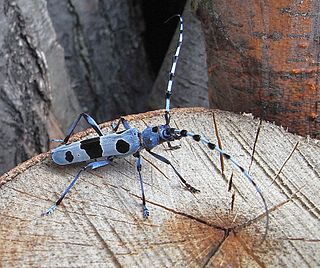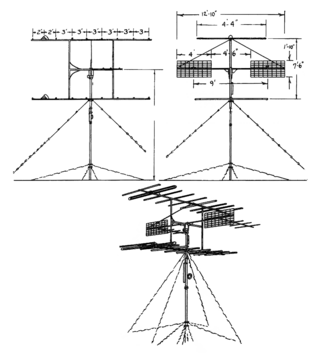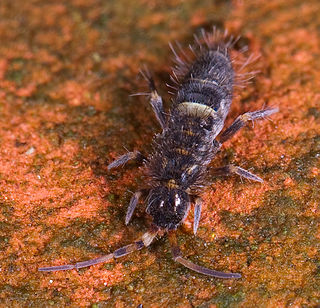In X-ray crystallography, wide-angle X-ray scattering (WAXS) or wide-angle X-ray diffraction (WAXD) is the analysis of Bragg peaks scattered to wide angles, which are caused by sub-nanometer-sized structures. It is an X-ray-diffraction method and commonly used to determine a range of information about crystalline materials. The term WAXS is commonly used in polymer sciences to differentiate it from SAXS but many scientists doing "WAXS" would describe the measurements as Bragg/X-ray/powder diffraction or crystallography.

Centipedes are predatory arthropods belonging to the class Chilopoda of the subphylum Myriapoda, an arthropod group which includes millipedes and other multi-legged animals. Centipedes are elongated segmented (metameric) creatures with one pair of legs per body segment. All centipedes are venomous and can inflict painful stings, injecting their venom through pincer-like appendages known as forcipules or toxicognaths, which are actually modified legs instead of fangs. Despite the name, no centipede has exactly 100 pairs of legs; the number of pairs of legs is an odd number that ranges from 15 pairs to 191 pairs.

Antennae, sometimes referred to as "feelers", are paired appendages used for sensing in arthropods.

A goniometer is an instrument that either measures an angle or allows an object to be rotated to a precise angular position. The term goniometry derives from two Greek words, γωνία (gōnía) 'angle' and μέτρον (métron) 'measure'. The protractor is a commonly used type in the fields of mechanics, engineering, and geometry.

X-ray spectroscopy is a general term for several spectroscopic techniques for characterization of materials by using x-ray radiation.

The Antennae Galaxies are a pair of interacting galaxies in the constellation Corvus. They are currently going through a starburst phase, in which the collision of clouds of gas and dust, with entangled magnetic fields, causes rapid star formation. They were discovered by William Herschel in 1785.

High-frequency direction finding, usually known by its abbreviation HF/DF or nickname huff-duff, is a type of radio direction finder (RDF) introduced in World War II. High frequency (HF) refers to a radio band that can effectively communicate over long distances; for example, between U-boats and their land-based headquarters. HF/DF was primarily used to catch enemy radios while they transmitted, although it was also used to locate friendly aircraft as a navigation aid. The basic technique remains in use as one of the fundamental disciplines of signals intelligence, although typically incorporated into a larger suite of radio systems and radars instead of being a stand-alone system.
A diffractometer is a measuring instrument for analyzing the structure of a material from the scattering pattern produced when a beam of radiation or particles interacts with it.
Range of motion is the linear or angular distance that a moving object may normally travel while properly attached to another.

A goniometer is often included in analog audio equipment to display a Lissajous figure which shows the amount of stereo in a dual-channel signal. It allows the sound technician to adjust for optimal stereo and determine the makeup of errors such as an inverted signal. Many goniometers also provide a VU or PPM as a secondary function. A goniometer adapted for surround metering is called a 'jellyfish display'. This term was coined by DK-Technologies A/S from Denmark.

A positioning goniometer or goniometric stage is a device used to rotate an object precisely about a fixed axis in space. Its appearance is similar to that of a linear stage. However, rather than moving linearly with respect to its base, the stage platform rotates partially about a fixed axis above the mounting surface of the platform. The distance of the center of rotation from the platform mounting surface is often chosen so that two different goniometer models may be stacked in an X-Y configuration and both stages will rotate about the same point. Positioning goniometers typically use a worm drive with a partial worm wheel fixed to the underside of the stage platform meshing with a worm in the base. The worm may be rotated manually or by a motor as in automated positioning systems.

Miniflex is an X-ray diffraction (XRD) analytical measuring instrument produced by Rigaku. The current instrument is the fourth in a series introduced in 1973.
A crystallographic database is a database specifically designed to store information about the structure of molecules and crystals. Crystals are solids having, in all three dimensions of space, a regularly repeating arrangement of atoms, ions, or molecules. They are characterized by symmetry, morphology, and directionally dependent physical properties. A crystal structure describes the arrangement of atoms, ions, or molecules in a crystal.

The "Pegmantit 3" or P-3 was an early VHF radar developed and operated by the former Soviet Union.

The "Pegmantit 8" or P-8 was an early 2D VHF radar developed and operated by the former Soviet Union.

The P-12 "Yenisei" was an early VHF radar developed and operated by the former Soviet Union.

Orchesella cincta is a species of springtail present in North America and Europe. They average 4 millimetres (0.16 in) in length, which is extremely large as most springtails don’t grow past 1 millimetre. The specific name cincta means "belted" and refers to the distinctive colouration of the third abdominal segment.

A Bellini–Tosi direction finder is a type of radio direction finder (RDF), which determines the direction to, or bearing of, a radio transmitter. Earlier RDF systems used very large rotating loop antennas, which the B–T system replaced with two fixed antennae and a small rotating loop, known as a radiogoniometer. This made RDF much more practical, especially on large vehicles like ships or when using very long wavelengths that demand large antennae.

Meloe americanus is a type of blister beetle (Meloidae) found in North America. It is most relevant to the fields of agriculture and veterinary medicine. Adult beetles feed on different types of plants, which cause crop damage. They also release a fluid containing a chemical that is toxic, and at high concentrations lethal, to mammals. The first instar larvae are uniquely active and mobile, utilizing phoresy and parasitism to feed and mature through their developmental stages.
The Giant Radio Array for Neutrino Detection (GRAND) is a proposed large-scale detector designed to collect ultra-high energy cosmic particles as cosmic rays, neutrinos and photons with energies exceeding 1017 eV. This project aims at solving the mystery of their origin and the early stages of the universe itself. The proposal, formulated by an international group of researchers, calls for an array of 200,000 receivers to be placed on mountain ranges around the world.














